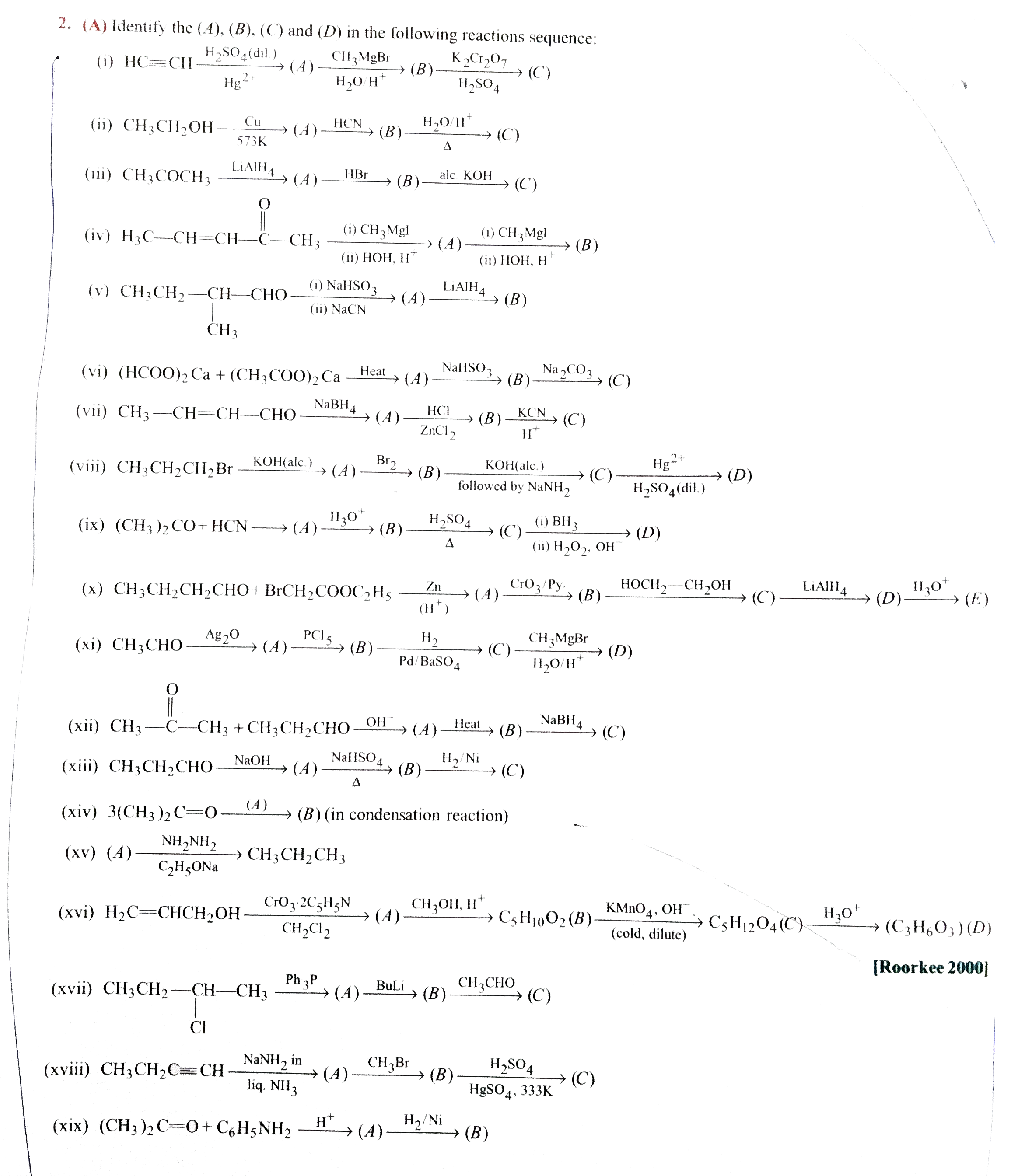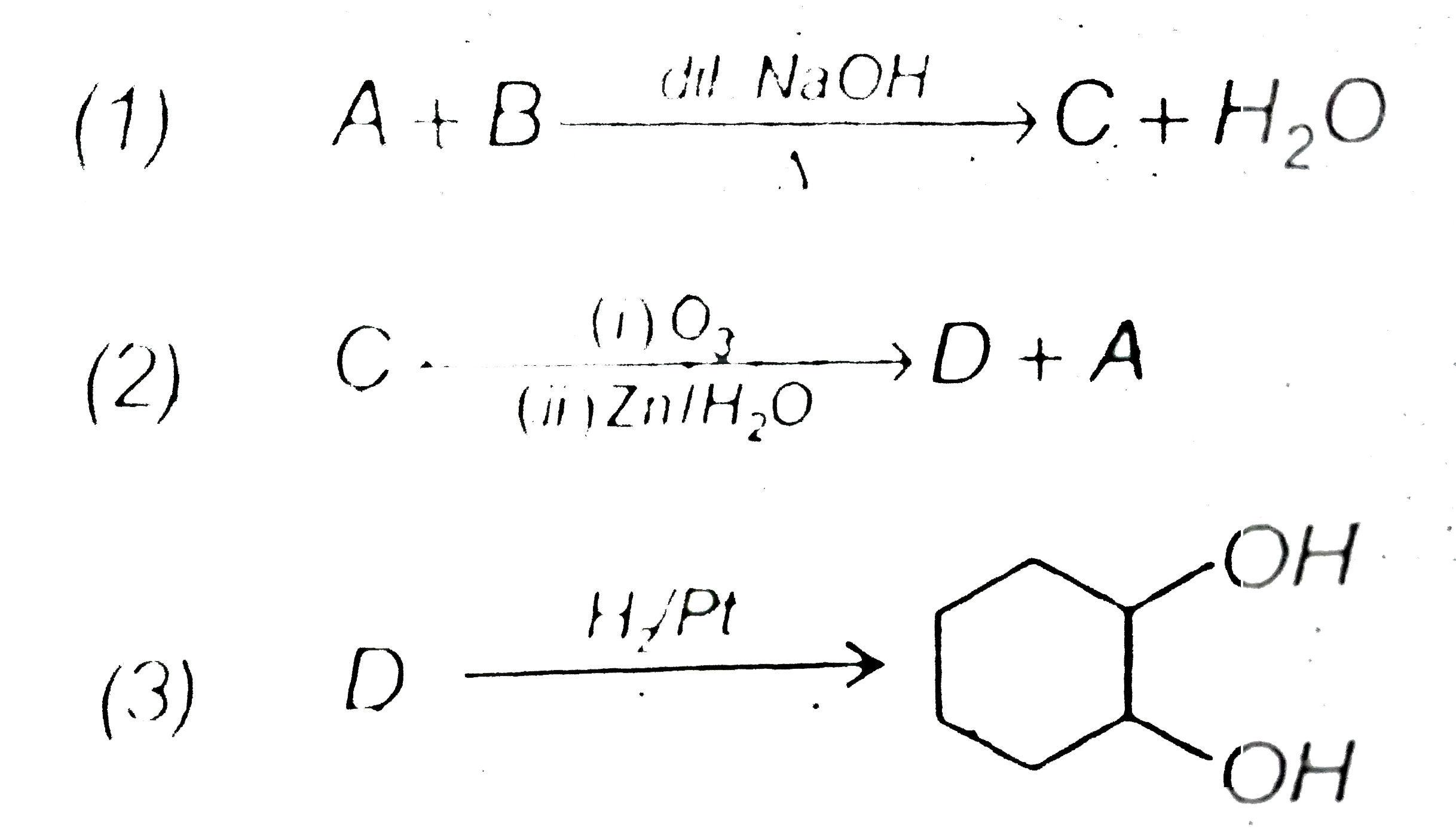Identify A, B, C and D in the given sequence of reactions.
2A+2B→2AOH+H2
S+O2→C
C+B→D
A-Na, B-H2O, C-SO2, D-H2SO3
A-Na, B-H2O, C-SO2, D-H2SO4
A-K, B-H2O, C-SO2, D-H2SO4
A-K, B-H2O, C-SO3, D-H2SO3
The correct Answer is:A
To solve the problem and identify A, B, C, and D in the given sequence of reactions, we can analyze each reaction step by step.
Step 1: Analyze the first reaction
The first reaction is:
2A+2B→2AOH+H2
Here, we see that two moles of substance A react with two moles of substance B to produce two moles of AOH (which is a hydroxide) and hydrogen gas (H₂).
- Since AOH is a hydroxide, A must be a metal that forms a hydroxide when it reacts with water. The most likely candidates for A are alkali metals (from Group 1 of the periodic table), such as sodium (Na) or potassium (K).
Step 2: Identify B
Since A reacts with B to form AOH and H₂, and knowing that hydroxides are typically formed when metals react with water, we can conclude that:
- B is water (H₂O).
Step 3: Analyze the second reaction
The second reaction is:
S+O2→C
In this reaction, sulfur (S) reacts with oxygen (O₂) to form a compound C. The most common product of this reaction is sulfur dioxide (SO₂). Therefore:
- C is sulfur dioxide (SO₂).
Step 4: Analyze the third reaction
The third reaction is:
C+B→D
Substituting C and B into this reaction gives us:
SO2+H2O→D
When sulfur dioxide reacts with water, it forms sulfurous acid (H₂SO₃). Therefore:
- D is sulfurous acid (H₂SO₃).
Summary of Identifications
- A: Sodium (Na) or Potassium (K) (alkali metal)
- B: Water (H₂O)
- C: Sulfur dioxide (SO₂)
- D: Sulfurous acid (H₂SO₃)
Final Answer
- A = Sodium (Na) or Potassium (K)
- B = Water (H₂O)
- C = Sulfur dioxide (SO₂)
- D = Sulfurous acid (H₂SO₃)
The first reaction is:
2A+2B→2AOH+H2
Since A reacts with B to form AOH and H₂, and knowing that hydroxides are typically formed when metals react with water, we can conclude that:
- B is water (H₂O).
The second reaction is:
S+O2→C
- C is sulfur dioxide (SO₂).
The third reaction is:
C+B→D
SO2+H2O→D
- D is sulfurous acid (H₂SO₃).
- A: Sodium (Na) or Potassium (K) (alkali metal)
- B: Water (H₂O)
- C: Sulfur dioxide (SO₂)
- D: Sulfurous acid (H₂SO₃)
- A = Sodium (Na) or Potassium (K)
- B = Water (H₂O)
- C = Sulfur dioxide (SO₂)
- D = Sulfurous acid (H₂SO₃)
Topper's Solved these Questions
- BOOK - MTG IIT JEE FOUNDATIONCHAPTER - MATERIALS : METALS AND NON-METALSEXERCISE - EXERCISEInteger/Numerical Value Type)5videos
MATERIALS : METALS AND NON-METALS
- BOOK - MTG IIT JEE FOUNDATIONCHAPTER - FOOTSTEPS towards(CBSE Board)EXERCISE - SECTION - D14videos
FOOTSTEPS towards(CBSE Board)
- BOOK - MTG IIT JEE FOUNDATIONCHAPTER - MATTER : ELEMENTS COMPOUNDS AND MIXTURES EXERCISE - EXERCISE (INTEGER/NUMERICAL VALUE )5videos
MATTER : ELEMENTS COMPOUNDS AND MIXTURES
Similar Questions
Identify the (A),(B),(C) and (D) in the following reactions sequence:


 View Solution
View Solutiona. (A) (yellow coloured solution ) changes to light green coloured solution (B) on passing H2S gas (A) and (B) both give white ppt. with BaCI2 solution, insoluble in conc. HCI(A) given blue coloured ppt (C ) with K4[F2(CN)6] B does not .What are (A),(B) and (C )?
b. Identify A,B,C and D in the following reactions Bauxite + chemical +CI2Δ−−→A+CO
A+H2O→B+HCI,B+H2SO4→C+H2O
B+NaOH→D+H2OView Solution
Knowledge Check
- Question 1 - Select One or More
Identify A, B, C and D in the following reaction sequence
 AThe compound A is (CH3)2SiCl2BThe compound C and D are SiO2 and SiC respectivelyCThe compound B is (CH3)2Si(OH)2DThe compound B is (CH3)2Si=O
AThe compound A is (CH3)2SiCl2BThe compound C and D are SiO2 and SiC respectivelyCThe compound B is (CH3)2Si(OH)2DThe compound B is (CH3)2Si=O - Question 2 - Select One
Identify (B) and (D) in the following sequence of reactions:
H2C=CH2conc.H2SO4−−−−−−−→(A)H2O−−→Δ(B)PB3−−→(C)(D)−−→(H2C=CH2)ACH3OH and C2H5BrBC2H5HSO4 and alc. KOHCC2H5OH and alc. KOHDC2H5HSO4 and aq. KOH - Question 3 - Select One
Identify A ,B ,C and D and the following reactions :
Nitrobenzene Sn/HCI−−−−−→ABr2−−−−−−→Excess
BNaNO2/HCI−−−−−−−−−→273kCH3PO2/H2O−−−−−−−→DAA = aniline , B = 2,4,6- tribromoniline
C= 2,4,6 - tribromo benzene diazonium chloride
D= 1,3,5- tribromo benzeneBA= benzene B = 2,4,6- tribromo benzene
C= 2,4,6- trichloro benzene
D= 2,4,6- trichloro phenolCA= aniline B= P- bromoaniline
C= P- bromobenzene diazonium chloride
D= p- bromo phenolDA = aniline B= p- bromo aniline
C= p- bromobenzene diazonium chloride
D= bromo benzene
Identify (A), (B), (C) and (D) and given their chemical formulae.
(A)+NaOH→NaCl+NH3)+H2O
NH3+CO2+H2O→(B)
(B)+NaCl→(C)+NH4Cl
(C)Heat−−→NaCO3+H2O+(D)View SolutionIdentify A-D in the following reactions .

(1) A+BdilNaOH−−−−−→ΔC+H2O
(2) CdilNaOH−−−−−−−→(ii)Zn/H2OD+A
(3) View Solution
View SolutionConsider the following sequence of reactions:
B2O3+CaF2+H2SO4→(A)+(B)+H2O
(A)+LiAlH4→(C)(g)+(D)+LiF
(C)+H2O−−→Δ(D)+H2↑⏐⏐
(D)+Na2CO3→(E)+NaBO2+CO2↑⏐
(E)+NH4Cl→(F)+B2O3+NaCl+H2O
What is the empirical mass of compound (F)?View SolutionWrite the reactions of B2H6 with (a) H2O (b) O2 (c) NH3.
View SolutionThe product (D ) in the following sequence of reaction is
CH3COOHNH3−−→(A) Heat −−−−→(B)
P2O5−−→(C)Na+C2H5OH−−−−−−−−→(D)View Solution

